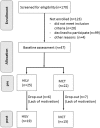Effects of Endurance Exercise Modalities on Arterial Stiffness in Patients Suffering from Unipolar Depression: A Randomized Controlled Trial
- PMID: 29403399
- PMCID: PMC5786741
- DOI: 10.3389/fpsyt.2017.00311
Effects of Endurance Exercise Modalities on Arterial Stiffness in Patients Suffering from Unipolar Depression: A Randomized Controlled Trial
Abstract
Background: Psychiatric disorders are associated with a higher prevalence of cardiovascular disease and mortality. Regular exercise has been shown to reduce depressive symptoms and improve arterial stiffness as a biomarker of cardiovascular risk. We aimed to investigate the effects of different exercise modalities on depression severity index and arterial stiffness in patients suffering from unipolar depression.
Methods: 34 patients suffering from unipolar depression [female: 25, male: 9, age: 37.8, Beck-Depression-Inventory-II (BDI-II) score: 31.0] were enrolled in this two-armed randomized controlled trial. Central hemodynamics, augmentation index at heart rate 75/min (AIx@75) and aortic pulse wave velocity (PWV) were obtained by an oscillometric monitoring device. Maximal bicycle ergometer exercise testing yielded maximal fitness parameters. Patients were assigned to either high-intensity low volume (HILV) or moderate continuous aerobic training (MCT). Both intervention groups trained three times a week during a 4-week intervention period. BDI-II were filled out by the patients before and after the intervention period.
Results: We found moderate interaction effects on depression severity reduction [Formula: see text]. HILV showed a 85% beneficial effect in lowering BDI-II scores compared to MCT (HILV: pre: 28.8 (9.5), post: 15.5 (8.5), SMD = 1.48), MCT: (pre: 33.8 (8.5), post: 22.6 (7.5), SMD = 1.40). Reduction of AIx@75 was more pronounced after MCT (SMD = 0.61) compared to HILV (SMD = 0.08), showing 37% possibly beneficial effects of MCT over HILV. PWV remained unchanged in both training groups.
Conclusion: Both training regimes showed large effects on the reduction of depressive symptoms. While HILV was more effective in lowering depression severity, MCT was more effective in additionally lowering peripheral arterial stiffness. Exercise should be considered an important strategy for preventive as well as rehabilitative treatment in depression.
Keywords: arterial stiffness; cardiovascular risk; depression; high-intensity exercise training; prevention.
Figures
Similar articles
-
Effects of different endurance exercise modalities on retinal vessel diameters in unipolar depression.Microvasc Res. 2018 Nov;120:111-116. doi: 10.1016/j.mvr.2018.07.003. Epub 2018 Jul 24. Microvasc Res. 2018. PMID: 30048648 Clinical Trial.
-
Superior Effects of High-Intensity Interval Training vs. Moderate Continuous Training on Arterial Stiffness in Episodic Migraine: A Randomized Controlled Trial.Front Physiol. 2017 Dec 19;8:1086. doi: 10.3389/fphys.2017.01086. eCollection 2017. Front Physiol. 2017. PMID: 29311997 Free PMC article.
-
Acute effects of interval versus continuous endurance training on pulse wave reflection in healthy young men.Atherosclerosis. 2015 Feb;238(2):399-406. doi: 10.1016/j.atherosclerosis.2014.12.038. Epub 2014 Dec 23. Atherosclerosis. 2015. PMID: 25558034 Clinical Trial.
-
Effect of combined aerobic and resistance training versus aerobic training on arterial stiffness.Int J Cardiol. 2015 Jan 15;178:69-76. doi: 10.1016/j.ijcard.2014.10.147. Epub 2014 Oct 24. Int J Cardiol. 2015. PMID: 25464222 Review.
-
Psychosocial interventions for preventing and treating depression in dialysis patients.Cochrane Database Syst Rev. 2019 Dec 2;12(12):CD004542. doi: 10.1002/14651858.CD004542.pub3. Cochrane Database Syst Rev. 2019. PMID: 31789430 Free PMC article.
Cited by
-
A Rapid Review of Randomized Trials Assessing the Effects of High-Intensity Interval Training on Depressive Symptoms in People with Mental Illness.Int J Environ Res Public Health. 2022 Aug 25;19(17):10581. doi: 10.3390/ijerph191710581. Int J Environ Res Public Health. 2022. PMID: 36078299 Free PMC article. Review.
-
Effects of High-Intensity Interval Training on Central Blood Pressure: A Systematic Review and Meta-Analysis.Arq Bras Cardiol. 2023 Mar;120(4):e20220398. doi: 10.36660/abc.20220398. Arq Bras Cardiol. 2023. PMID: 37098987 Free PMC article. English, Portuguese.
-
A Cross-Sectional Investigation of the Association between Arterial Stiffness and Depressive Symptoms, Anxiety Symptoms, and Quality of Life.Medicina (Kaunas). 2023 Feb 28;59(3):477. doi: 10.3390/medicina59030477. Medicina (Kaunas). 2023. PMID: 36984478 Free PMC article.
-
Sprint Interval Training and Continuous Aerobic Exercise Training Have Similar Effects on Exercise Motivation and Affective Responses to Exercise in Patients With Major Depressive Disorders: A Randomized Controlled Trial.Front Psychiatry. 2018 Dec 21;9:694. doi: 10.3389/fpsyt.2018.00694. eCollection 2018. Front Psychiatry. 2018. PMID: 30622487 Free PMC article.
-
Aerobic Physical Exercise as a Non-medical Intervention for Brain Dysfunction: State of the Art and Beyond.Front Neurol. 2022 May 13;13:862078. doi: 10.3389/fneur.2022.862078. eCollection 2022. Front Neurol. 2022. PMID: 35645958 Free PMC article. Review.
References
-
- World Health Organization. Fact Sheet 369: Depression. Geneva: WHO; (2012).
-
- NICE. Depression: the treatment and management of depression in adults. NICE Clin Guideline (2013) 90:5–53.
LinkOut - more resources
Full Text Sources
Other Literature Sources


